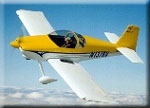
 | Project - Notes |
 |
| ||||||
|
Home Project News February 3, 2021 Project Log FAQ Project Notes Project Summary Guestbook Other Stuff | There seems to be some confusion about how the AFP fuel injection system is plumbed. Specifically how the purge valve is set up. I must admit that I was confused as well when I started so I called AFP and asked. The engineer told me that there is no return line on the AFP fuel injection system. There is a purge line. This line allows you to bypass fuel around the flow divider on top of the engine so that you can replace all the fuel in the system with fresh fuel from the tanks. This purge valve has two advantages. First, it allows you to get rid of any hot fuel that may be in the system that makes traditional fuel injection systems difficult to start when hot, due to the fuel boiling and causing vapor lock. The second advantage is if the purge valve itself is used to shut off the engine (instead of the mixture) the fuel pump is completly unloaded. When using the mixture to shut the fuel off to the engine a valve inside the fuel servo is closed blocking fuel from flowing to the divider. This valve is not bubble tight and the little bit of pressure left in the diaphram of the fuel pump could allow a little fuel to seep into the intake plenum. This could ruin your day if you moved the prop and got a little help from your magneto. If you use the purge valve to shut the engine off it bypasses the flow divider and the engine will die quite quickly and the entire fuel system will be brought down to ambient pressure which will not allow any fuel to flow anywhere. Even high winged airplanes would benefit here if the purge valve were left in the bypass position, but beware a leaky purge valve. In a low winged airplane it would be impossible for fuel to make it's way into a cylinder. Now for the plumbing. The most obvious way to plumb the purge line is through a duplex fuel valve, which would switch the purge line along with the supply line from Left to Right as the selector is moved. These beauties are rather expensive, and according to AFP, uncessesary. The way it was explained to me was to use a small piece of 1/4" hose from the purge valve to a bulkhead connector on the firewall. Then run a 1/4" aluminum line from that bulkhead to a T between one of the tanks and the fuel selector. With this arrangement it is quite simply a matter of selecting the opposite tank when purging. The purge should use at most a pint of fuel, which means that you would be pumping a very small amount of fuel from one tank to the other during the purge. If you forget to switch the tank to the opposite one from where the Tee is installed you will simply be recirculating some of the fuel that was in there to begin with. No real harm done, other than you didn't really purge the system. This plumbing made a lot of sense to me because it is very simple and easy to install. It should be pretty easy to teach myself to select the left tank for purging and starting. A duplex valve and two more holes in the fuel tank would be more elegant and foolproof but at the expense of a bunch of money, fittings, and tubing. One of my primary goals on the fuel system is simplicity and reliability. One of the main causes for power reductions (read engine failure) on Experimental aircraft during Phase I testing is fuel starvation. Keep It Simple!! My starting sequence will something on the order of...
|